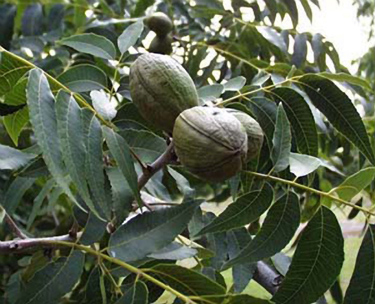
Commercial pecan production is a complex practice, requiring considerable knowledge of the pecan tree and of the limiting factors involved in the production of the pecan crop. One of the major constraints involved in the production of pecans is the alternate or irregular bearing tendency, which is an innate survival characteristic of the tree. Years of heavy crop load are termed “on” years, while those with poor crop loads are termed “off” years. In order for a commercial pecan operation to be consistently successful, the goal of the operation should be annual production of a moderate crop of high quality nuts, rather than the production of a high yield in a single given year. Culturally, there are several basic factors that will help to promote optimum profitability with a commercial pecan orchard.
Fertilization
Proper nutrition is a key requirement for the reliable production of quality pecans. Like other plants, pecans require nutrients for optimal growth and fruit production. Fertilizers supply nutrients to soils and help correct nutrient deficiencies. Three of the six macronutrients needed by pecans are commonly deficient in Georgia soils. These include nitrogen, potassium and magnesium. Three of the seven micronutrients required by pecans are commonly deficient as well: zinc, boron and iron. Recent attention has also been given to deficiencies of nickel in pecan orchards located on Coastal Plain soils.
The most reliable indicator of the nutritional needs of the pecan tree is the foliar or leaf analysis. Soil samples are less efficient for determining nutritional deficiencies in mature orchards but are quite useful for monitoring soil pH and lime requirements. Leaf analysis is more sensitive to changes in nutrient supply because it measures amounts of specific nutrients in the leaves. Sample leaves for analysis between July 7 and August 7, as this is the period in which nutrient concentrations in the leaves are most stable. Nutrient sufficiency levels are shown in Table 1.
| Table 1. Leaf Sufficiency levels for essential elements of pecans | |
| Element | Sufficiency Ranges |
| N (%) | 2.5-3.3 |
| P (%) | 0.12-0.3 |
| K (%) | 1.25-2.5 |
| Mg (%) | 0.35-0.6 |
| Ca (%) | 1.3-1.5 |
| S (%) | 0.25-0.5 |
| Zn (ppm) | 50-100 |
| Fe (ppm) | 50-300 |
| Mn (ppm) | 100-800 |
| B (ppm) | 50-100 |
| Cu (ppm) | 6-30 |
Nitrogen
Nitrogen is the element that most commonly limits pecan growth and ultimately orchard profitability. It provides better tree growth, a higher percent kernel, and a healthier tree. When properly maintained, nitrogen helps to ensure optimal year to year production. Nitrogen deficiencies cause poor growth and poor tree health. Excessive nitrogen stimulates excess foliage, shading and, in some instances, reduced yield. The key to nitrogen management is to balance timely availability with tree demand.
The management of nitrogen fertilization in the pecan orchard will vary for irrigated versus non-irrigated orchards and from year to year within a given orchard, depending upon crop load.
Nitrogen uptake in the pecan tree is driven by demand. The two critical periods of nitrogen demand during the season are early foliage growth and kernel filling. The early spring foliage flush is nourished primarily from reserves held within the tree, while the nitrogen demand during the kernel fill stage is usually satisfied from soil uptake. If nitrogen is limited at kernel filling, then the tree will mobilize nitrogen from the foliage to the kernels.
Nitrogen recommendations have evolved greatly over the years. Historically, recommendations have been to apply nitrogen in March or as a split application in March and May or June. A general “rule of thumb” for mature, well managed, irrigated orchards is to apply 10 lbs. of nitrogen /acre for every 100 lbs. of expected crop.
In the absence of leaf sample recommendations, fertilize dryland orchards with 100-150 lbs. of nitrogen made in split applications. Apply the first in late February or early March so winter rains will help improve soil moisture and, ultimately, nitrogen uptake. The second application can be made in May or June. Soil moisture and nitrogen uptake can be more easily controlled by the grower in irrigated orchards, where trees are more efficient in using nitrogen.
An alternative to the March/May or June split is to split the application between mid-spring and late summer. This timing works best for orchards bearing heavy crops and where other limiting factors are controlled. Well-managed trees coming off an “off” year begin spring foliage growth with a full supply of nutrients stored in the stems, trunk and roots. As a result, they demand little nitrogen, and healthy trees will not remove much nitrogen from the soil at this time. A more efficient use of nitrogen may be to apply ⅓ of the nitrogen required when the shoots are 75 percent expanded, which generally occurs in mid to late April in Georgia.
During “off” years, the April application alone is sufficient. During July, trees may be assessed with regard to their crop load. If the crop load is heavy, apply another ⅓ of the full rate in early to mid August. Apply the final ⅓ in early September to help maintain healthy foliage for optimum kernel filling, leaf retention and adequate nutrient storage pools. For example, with an expected crop of 1500 lbs./acre, the nitrogen would be applied as 50 lbs/acre in mid-late April, 50 lbs. in early August, and 50 lbs in early September. If only two applications are made per year, apply half the recommended nitrogen in April and again in late August.
The kernel filling process pulls nitrogen from the leaves. During an “on” year with heavy crop loads, these leaves must have soil nitrogen to remain healthy and fully functional. Once the kernel-filling process is complete, healthy leaves will maintain sufficient nitrogen to produce energy stores. Trees in the “off” cycle of production will have sufficient nitrogen and will not need late-summer applications.
Though more complex than the March or March/ May applications, spring and late summer splits make for more efficient use of nitrogen by the tree, better meet the needs of the tree, and can help reduce the severity of alternate bearing if the orchard is otherwise well managed.
Phosphorous
Phosphorous is important for energy storage as well as the production of wood and nuts. Despite its value, phosphorous levels in Georgia soils are often adequate, and additional phosphorous should not be applied unless called for by leaf analysis. The predominant symptom of phosphorous deficiency is dull green foliage with no interveinal chlorosis. Such deficiencies are often overlooked and are easily mistaken for mild nitrogen deficiency. In heavy bearing varieties, phosphorous deficiency can be expressed as a marginal leaf scorch, which may begin 7-10 days before shuck split, and premature defoliation. High concentrations of phosphorous can inhibit the uptake of nitrogen as well as iron, zinc and copper by the pecan tree.
Phosphorous is relatively immobile in the soil, so a single application of 60-100 lbs. of P2O5 incorporated at planting can last for several years. Subsequent applications, as needed, should also be incorporated because surface applications require several years to be of benefit to the orchard. Make applications any time leaf levels fall below 0.12 percent.
Potassium
Potassium is essential for the movement of carbohydrates, regulation of osmosis, and the activation of enzymes within the pecan tree. The resistance of pecan trees to winter injury is also heavily influenced by potassium levels.
Maintaining an appropriate balance of nitrogen and potassium within the tree is vital. If leaf potassium content is near minimum levels, heavy nitrogen applications will induce a visible potassium shortage termed “nitrogen scorch.” Nitrogen scorch can lead to serious defoliation (Figure 1), which appears first on the basal shoots and leaves, progressing upward. Scorched areas occur along the leaf margins, and are circular or oblong and about the size of a dime (Figure 2). Desirable and Schley trees are often especially sensitive to the nitrogen-potassium imbalance.
 Figure 1. Pecan tree suffering from serious defoliation in July due to nitrogen:potassium imbalance.
Figure 1. Pecan tree suffering from serious defoliation in July due to nitrogen:potassium imbalance.Less severe symptoms of potassium deficiency begin as an irregular interveinal chlorosis. As potassium concentrations decrease through the season, the chlorosis may spread up the shoot and leaf. Necrotic spots may develop on the surface of the leaf.
Transport of potassium from the leaves to the fruit often accelerates potassium deficiencies, particularly in heavy crop years. Such deficiencies may induce premature defoliation, shoot die back, and small, poorly filled nuts.
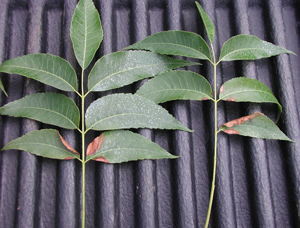 Figure 2. Leaf scorch of pecan due to nitrogen: potassium imbalance.
Figure 2. Leaf scorch of pecan due to nitrogen: potassium imbalance.
The most common method of supplying potassium is by soil application of muriate of potash. Rates should be based on leaf potassium and the amount of nitrogen applied. The nitrogen/potassium ratio should be maintained at 2:1 for most varieties in order to prevent leaf scorch. Apply during February before the onset of winter rains. Where late summer applications of nitrogen are used, additional applications of potassium should be made at that time if potassium levels in the leaf are marginal.
Application of foliar sprays using 2 to 4 lbs. of potassium nitrate per 100 gallons of water with the second and third cover sprays may be beneficial in reducing potassium deficiency the first and second years following diagnosis.
Magnesium
Magnesium deficiency is relatively rare in pecan trees; however, it can occur in trees growing on dry, acid, or sandy soils, especially in orchards with high soil potassium levels. Magnesium deficiencies are characterized by an intervienal chlorosis , which forms a “Christmas tree” pattern on the leaf. In very severe cases, a marginal leaf scorch may follow chlorosis.
Magnesium deficiency is best prevented by maintaining soil pH at 6.0-6.3 and by the use of dolomitic limestone as a liming material. Dolomitic limestone contains both calcium and magnesium, and generally provides an adequate amount of magnesium for most orchards. Growers will usually be able to observe increases in their leaf magnesium levels the second growing season following application. Where trees are identified as magnesium deficient, magnesium sulfate is more effective at raising leaf magnesium levels because it is more water soluble. Deficient trees will respond more quickly to foliar sprays of magnesium sulfate (5 lbs/100 gal) applied from the first leaf stage through July, but soil application of magnesium will still be necessary to maintain adequate levels in orchard soils.
Zinc
Zinc has a major influence on the economic return of a pecan operation due to its effect on flowering, fruit size, leaf efficiency and nut yield. It is particularly important to leaf expansion and shoot elongation. Zinc must be available to the tree at these specific times during the growing season. The most familiar characteristic of zinc deficiency is a curling of young leaves, causing a wavy leaf margin (Figure 3). Additional symptoms may be a rosette pattern, narrow leaves and terminal die-back.
Even with adequate soil levels, the availability of zinc in the soil depends upon soil pH, nitrogen, and phosphorous application. Liming soils with marginal zinc levels can reduce zinc uptake, particularly when nitrogen and phosphorous are applied in combination with lime. Zinc can usually be maintained at adequate levels under a liming program on acid soils if zinc is also applied. One advantage of soil applied zinc is that one application should provide an adequate supply of available zinc for many years to come.
Zinc moves slowly in the soil, requiring two or more years for a surface application to become effective. Therefore, foliar zinc applications are the most effective means of correcting the problem when deficiencies occur. Three to six applications per season are normally recommended, depending on the severity of the deficiency, with the first spray being applied about two weeks after bud break. Apply sprays at 2 week intervals over the period of shoot elongation. Apply foliar zinc any time leaf concentrations fall below 50 ppm or when visible symptoms of zinc deficiency are present.
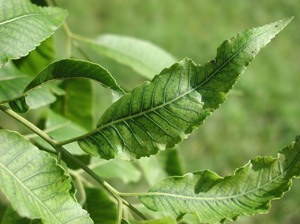 Figure 3. Symptoms of zinc deficiency in pecan.
Figure 3. Symptoms of zinc deficiency in pecan.Iron
As a component of chlorophyll, iron is essential to the process of photosynthesis. Iron deficiency rarely occurs from lack of iron in the soil but is induced by over-liming; cold, wet spring weather; or high soil concentrations of zinc, phosphorous or manganese. The deficiency generally occurs early in the growing season and clears up as the season progresses.
Symptoms of iron deficiency look similar to nitrogen deficiency, exhibiting chlorosis of the leaf. The interveinal chlorosis in iron deficiency sometimes retains very pronounced green veins. Also, with iron deficiency, young leaves are the first to be affected.
Depending upon the cause of iron deficiency, correction may take varying routes, including foliar applications of iron, changing the amount of lime applied to the orchard, or foregoing phosphorous applications. In most cases, the problem will clear up as the season progresses, especially when due to cool, wet spring conditions.
Iron deficiency is normally associated with older trees and may only occur in certain trees within the orchard. This deficiency may be genetically controlled, in which case it would be affected by rootstock.
Nickel
A deficiency of nickel is responsible for the condition known as mouse ear in pecan. Nickel is required by the urease enzyme in plants for the efficient conversion of urea to ammonia. When nickel is at an insufficient level in the plant, urea is not converted as efficiently and toxicity may develop.
Nickel has long been considered a nanonutrient, meaning that most plants require only very low levels of nickel to fulfill their requirements. The nickel content of most orchard soils in Georgia is minimal. In addition, nickel competes with zinc and other micronutrients for uptake by pecan roots. Due to the heavy applications of zinc applied to most managed orchards over many years, nickel is often not taken into the tree at a sufficient level, causing “mouse ear” symptoms.
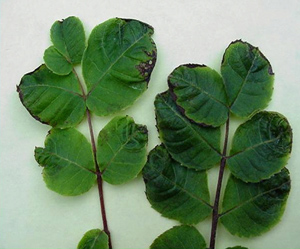 Figure 4. “Mouse Ear,” a symptom of nickel deficiency in pecan.
Figure 4. “Mouse Ear,” a symptom of nickel deficiency in pecan.Mouse ear first appears on the spring flush of growth. The most common symptom of mouse ear is a rounded or blunt leaflet tip. Affected leaves and leaflets are often smaller in size than healthy foliage. The rounded leaflet tips result from the buildup of urea to the point of toxicity in the leaf tissue (Figure 4).
Boron
Boron plays an important role in the movement of carbohydrates across cell walls and in the stability of the pollen germ tube. Inadequate boron can cause the germ tube to rupture, leading to reduced fertilization. Although leaf symptoms of boron deficiency in pecan are very rare, symptoms of deficiency and growth suppression can be expected to occur when leaf boron is less than 15 ppm. Normal growth is observed at 15-50 ppm, but preliminary results indicate that when leaf boron is between 50 and 100 ppm, pecan production is often enhanced through improved kernel percentage and better nut retention.
A major concern with regard to boron nutrition is the potential for toxicity. The acid soils of the southeastern United States are normally lower in boron than are alkaline soils. Soil-applied boron normally last for only one year, since boron is rapidly leached by rainfall and irrigation. Due to its affinity for leaching, soil boron levels may be affected by soil texture with a higher potential for leaching from sandy soils. Calcium, potassium and zinc compete with boron for uptake, so monitor leaf levels of all four nutrients. No studies have shown a yield response to soil-applied boron, but foliar applications have shown positive results.
Water Requirements
Water, particularly where nut quality is concerned, has more of an effect on pecan production than any other environmental factor. Drought stress affects nut size and filling as well as leaf and shoot growth. Adequate soil moisture is important at bud break in order to stimulate strong, vigorous growth from bloom through shell hardening for nut size, and during the nut filling stage for optimizing kernel percentage. If trees do not receive adequate soil moisture levels late in the season, shuck split and energy reserves are affected.
Pecan trees extract most of their water from the upper 32 inches of the soil profile. Though they are deep-rooted, most of the deep water available to the tree is considered survival water and is not useful for fruit production. The deeper the available water, the less water the tree will usually be able to absorb. Excessive water stress will cause the tree to shed leaves, drop nuts or only moderately fill the pecans.
The nut sizing period normally occurs from May 1 through August 15. Although not a critical water use stage for pecan, serious drought conditions during this period can affect yield. The most common visible effects of an extended drought during this period are excessive nut drop and “shell hardening” on small nuts. Lack of sufficient water during the nut sizing period causes small nuts and may lead to water stage fruit split, resulting from a sudden influx of water during the nut filling stage in some varieties.
The nut filling stage occurs from about August 15 to the first week of October, depending on variety. The most critical period for water use is during the first two weeks of September. Lack of sufficient water during the nut filling stage will lead to poorly filled nuts, which will result in poor nut quality.
Reports from other areas of the country indicate that as much as 350 gallons of water per day can be required by each tree during the nut filling stage. Based on this recommendation, if a mature orchard has a plant density of 12 trees per acre (60' x 60' spacing), then 4,200 gallons per acre per day may be needed. For a density of 20 trees per acre (46.5' x 46.5'), 7,000 gallons per acre per day may be needed.
Pecans can have high water requirements, using as much as 60 inches of total water (including rainfall) during the growing season. Drip and micro-irrigation system design capacity for a mature pecan orchard should be 3,600-6,000 gallons of water per acre per day.
Because of evaporation losses, solid-set sprinkler irrigation can require as much as three times more supplemental water as drip or micro-irrigation. Solid set irrigation systems should have a design capacity of 1.5–2.0 inches per week.
There is obviously a tradeoff between how much water the irrigation system can apply and the economics (initial cost) of the system. Growers should make certain they know the limitations of their irrigation system and how the system should operate in order to minimize the system’s weak points. Solid set irrigation systems obviously have different limitations than drip irrigation systems.
Whether an orchard is irrigated with solid-set sprinkler, drip or micro irrigation, an irrigation schedule that meets the needs of the pecan orchard will be required. There are several ways to schedule irrigation. Tensiometers, which are based on available soil moisture, and evaporation pans, which are based on evaporation rates, are the two most common scheduling methods. For solid-set systems, either method can be used but pan evaporation is the most common. Where drip or micro irrigation is used, tensiometers are the most common method. Solid-set sprinkler irrigation will allow moisture levels to fluctuate between 50 and 100 percent, where drip and micro irrigation maintain relatively constant soil moisture levels near emitters.
Operate systems for 12 hours or less per day to prevent water logging and oxygen depletion in the root zone. Roots thrive when water is present in the soil as a liquid film covering each soil particle while leaving soil interspaces filled with air. Growers should be aware of their system’s delivery rate and adjust their operation times accordingly. At the maximum rate, the system should have the capability to deliver the required gallons per acre per day or inches per week.
Proper scheduling of the irrigation system during the year could save money in operating costs. If a system is designed to operate 12 hours per zone during peak water usage, then it could be used at only a fraction of that time during the early part of the season due to the tree’s requirements at that stage. Depending on the irrigation system design, as few as 4 hours per zone may be sufficient during the first part of the growing season. Increase the operating time monthly until reaching the maximum 10-12 hours during peak water demand in late summer. A general operating schedule is provided in Table 2 for both solid set systems and drip or micro irrigation systems.
| Table 2. General operating schedule for pecan irrigation. | ||
| Month |
Drip/Micro
% cycle |
Sprinkler
Inches/Acre |
| April |
60
|
0.5"
|
| May |
70
|
0.75"
|
| June |
80
|
1.00"
|
| July |
90
|
1.25"
|
| August |
100
|
1.50"
|
| September |
100
|
1.50"
|
| October |
90
|
1.00"
|
| November |
60
|
0.5"
|
Crop Load Management
Excessive fruiting in pecan crops can cause economic losses due to reduced quality in the “on” year and, subsequently, a light return crop. Another effect may be tree limb breakage from excess weight. Several cultivars suffer from this type of over production including Cape Fear, Oconee, Schley, Stuart and Sumner.
Problems with over-production are related to a decrease in the number of leaves per fruit, especially in heavy crop years. On average, it takes 8-10 functional leaves to adequately fill one nut. Large fruited cultivars may require even more leaves per nut. Much of the stress on the leaves to fill nuts can be relieved by fruit thinning of prolific cultivars.
Fruit thinning may decrease total yield per tree for the current year, but this can be offset by an increase in marketable yield. The benefits of fruit thinning include increased nut quality in terms of higher kernel percentage and kernel grade as well as more stable yield and cash flow for the grower from year to year.
The process of kernel deposition requires a large amount of available carbohydrates. Each nut may compete with other nuts for carbohydrates produced by surrounding leaves or held in supporting branches. Fruit thinning prior to this competition provides each remaining nut with a greater supply of carbohydrates. The tree should still have enough carbohydrate reserves to support a flower crop the following season.
After fertilization, the ovule (the tissue that becomes the kernel) begins to expand and lengthen from the tip of the nut toward the stem. As the ovule expands, the space is filled with fluid until the ovule extends to the stem end of the nut. The shell begins to harden from the tip shortly after the nut reaches full size. After expansion is complete, kernel deposition begins.
In order to maximize return bloom, fruit thinning should be completed within two weeks from the time the ovule is one half expanded. If thinned too early, nuts will be difficult to shake from the tree. A straight, lengthwise cut through the center of the nut will expose the expanding ovule (a brown area) in order to help determine when it has reached 50 percent expansion (Figure 5). For much of the Georgia pecan belt, this will be in mid July. Fruit thinning after this time and throughout the water stage may improve nut quality for the current year, but will not substantially improve the return crop.
 Figure 5. Development of the ovule in the pecan nut. The nut on the left is not ready to be fruit thinned. The nut on the right has reached 50 percent ovule expansion (brown area) and is ready to be thinned.
Figure 5. Development of the ovule in the pecan nut. The nut on the left is not ready to be fruit thinned. The nut on the right has reached 50 percent ovule expansion (brown area) and is ready to be thinned.Fruit thinning can be accomplished with a conventional tree shaker equipped with donut or cylinder pads (Figure 6). These pads, filled with walnut hulls or glass beads, are not necessary but can help prevent trunk injury. A coating of silicon gel or grease between the rubber flap and the pad serves as an additional precaution (Figure 7). This allows movement between the flap and pad, preventing movement of the bark during shaking. Position the shaker as level as possible on the ground and hold the tree in the center of the shaker head for shaking. Under conditions of recent heavy rainfall, the cambium layer under the bark may slip more easily, resulting in a greater risk of tree injury. In order to minimize trunk damage, delay nut thinning for a few days following rain. If rainfall has been plentiful and trees are flushing new growth, only a small number of trees should be shaken and observed for 36 hours for signs of bark splitting.
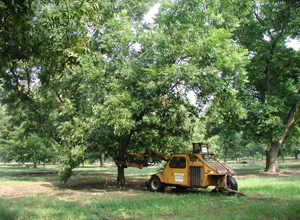 Figure 6. Fruit thinning of pecan.
Figure 6. Fruit thinning of pecan.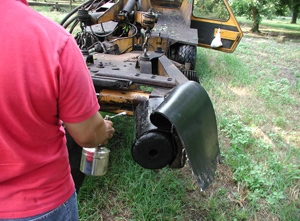 Figure 7. Application of silicon get between the flap and pad of a pecan shaker to prevent bark damage to pecan trees.
Figure 7. Application of silicon get between the flap and pad of a pecan shaker to prevent bark damage to pecan trees.
The quantity of nuts to remove varies depending upon nut size, cultivar, nut set, insect damage and disease incidence. Judging crop load is instrumental in determining if a crop needs thinning. This is a practice that takes experience. Trees with almost 100 percent of the shoots fruiting and a cluster size greater than three are overloaded and will benefit from thinning. Optimum crop load varies with cultivar and may range from 50-70 percent fruiting shoots. Many growers make the mistake of not removing enough nuts during thinning.
When shaking begins, do not be alarmed by the number of nuts that fall. Shake trees 2 to 3 seconds at a time, evaluated them, and shake them again if needed. Repeat this process two or three times when necessary until thinning is completed. The distribution of nuts removed throughout the tree may be enhanced by shaking from both north/south and east/west orientations. It is advisable to have one person on the ground watching what is happening as the trees are shaken. This person can communicate to the shaker operator when to stop and when to shake harder.
Proper management of crop load requires the grower to be familiar with the orchard. Not all cultivars or trees within a cultivar will require nut thinning in a given year. Thinning the pecan nut load in heavy crop years can be beneficial to nut quality and, for some varieties, to improving return bloom. Nut thinning is a sound management tool when used correctly. Growers should test nut thinning in a portion of their orchard and personally evaluate the results before using nut thinning as a regular practice.
Sunlight
Inadequate sunlight is highly limiting to pecan production. This situation may result from cloudy conditions, shading within the tree, or from shading among trees. Overcrowded trees become stressed as they receive insufficient sunlight, water and nutrients to fill the nuts and store carbohydrate reserves for the following season. In the southeastern United States, a properly spaced orchard should allow approximately 50-60 percent sunlight to reach the ground at noon.
Cloudy conditions are common in the southeastern United States during the pecan growing season. Years in which cloud cover is heavy throughout the season, specifically during kernel development, can have a limiting effect on nut quality in t
Status and Revision History
Published on Apr 19, 2006
Published on Feb 27, 2009
In Review on Jan 05, 2010
Published on Jan 21, 2010
Published with Full Review on Jan 22, 2013
Published with Full Review on Mar 28, 2017
Published with Full Review on Oct 25, 2024


























































